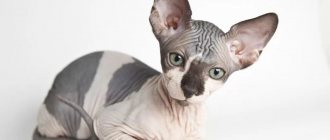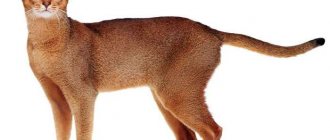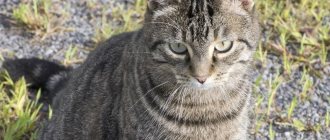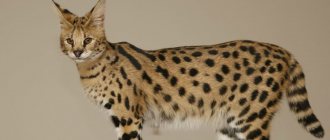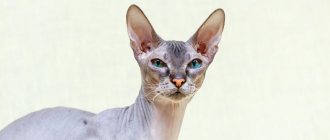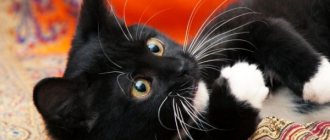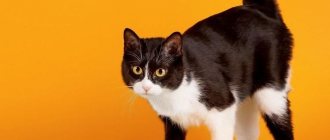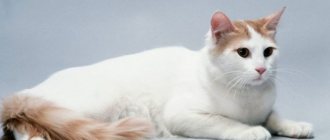Cats of different breeds and colors have a typical appearance: a cute face, a graceful body, slender legs and a long tail. Not all people know that there is a separate category of domestic representatives - tailless cats, unique breeds with an original appearance and friendly character.
In our country, such cats are rare, although every year more and more breeders are inclined to choose tailless breeds. They are especially popular among residents of Japan and China, where, according to popular beliefs and traditions, cats without a tail are a symbol of good luck and prosperity. Would you like to know the story of their origin? Then our article will be interesting and informative for you!
Types of rocks, their names and characteristics
Mekong Bobtail
This is the name of the stub-tailed breed, whose ancestor was the Siamese cat and cat. The variety was bred in Russia, but due to its external resemblance to Siamese cats, Mengkong Bobtail cats are often called Thai. Pedigree kittens are born with a short tail, and the configuration of the tail will always be different for each individual animal. Bobtails of this variety are real long-livers. The pet becomes strongly attached to its owner and loves to communicate constantly, which is especially important for people suffering from loneliness.
American Bobtail
Officially, this breed of cats with a short tail was registered in the 90s of the twentieth century. Until now, cats of the breed with short tails were considered inferior and defective. This fluffy beauty is the dream of many cat lovers. Kittens and adults have a good-natured, affectionate character. In addition, the animal gets along well with other pets. The color of the fur can be varied - red, gray, brown, black, tabby.
Manx cat
Some individuals of this species may still be born with such a process.
This breed of tailless cats is not always born with docked small tails. Some animals at birth have a long tail that looks like a fan. But most representatives are still short-tailed. Cats with flat spots where the “fifth limb” grows look as if they have lost an important appendage as a result of surgery.
The Manx cat rarely produces healthy offspring; adult cats are often infertile. The pet's character is playful and friendly. The animal quickly becomes attached to its owner and willingly plays with children. Fluffy cats are very active, they love to jump around the house, climbing to the highest places. Thanks to its developed intelligence, a kitten or adult cat is easy to train. The varieties of this breed have the following names:
- risen;
- stumpy.
Hybrid breeds
Tailless hybrid cats are in a separate category. The names and characteristics of each variety are as follows:
Such pets are kind and affectionate in nature towards people.
- Pixie bob. Representatives with chopped off tails are similar in appearance to a lynx. The animal has 7 toes on its front paws and 5 on its hind paws. A cat of this variety can be fluffy or smooth-haired. The character is flexible, calm, balanced.
- Skiff toy bob. Cats with a small pom-pom bunny tail are very cute and friendly creatures, similar in appearance to a Siamese cat.
- Oooh-bob. An animal with a docked tail, whose ancestors are the Siamese and Manx cats. This is an experimental breed that has an affectionate and friendly personality and a sweet, cute appearance.
- Snow bob. The variety is distinguished by an absolutely snow-white coat. The pet also has a good-natured character and gets along well with children and other pets.
- Twisty. It looks like a kangaroo because its hind legs are much longer than its front legs. Despite this feature, the animal gets along with its owner and loves other family members.
Japanese Bobtail
In ancient times, the Japanese believed that cats with a tail standing upright were friends of the devil and it was in this appendage that all the evil power resided. Therefore, cats were feared, shunned and even destroyed. However, in the late 60s of the last century, tailless cats were introduced to the world, which, according to Japanese beliefs, brought happiness and good luck. The Japanese Bobtail has an easy-going character, so he immediately becomes everyone's pet, ready to cuddle in his owner's arms and have fun playing with his children.
Kurilian Bobtail
In case of danger, such a pet will not offend anyone.
Another popular variety, characterized by docked short tails.
The tail may be slightly crooked, resembling a spiral, or similar to a stump or broom. The ancestors of the Kurilian are the Japanese bobtail and the Siberian cat. A representative of this breed resembles a dog in habits. If an animal feels threatened, it will immediately rush at the enemy, defending the territory, the owner, and itself. In addition, Kurils love to talk, tell their owner about their day, and tell about their problems.
Why are cats tailless?
Geneticists couldn't ignore tailless cats
and conducted research on the biological nature of species and developed their theory about their origin.
Cats with short tails were the result of natural selection, the influence of a mutated gene that passed from cat to cat in each generation.
Today there are several varieties of breeds without a tail. Some do not have it at all, while others have several vertebral segments that look like a fluffy pom-pom.
Health and illness
There is an opinion that cats with crooked, cropped tails are defective and inferior. However, it is not. Despite the unusual body structure, the animal is in fairly good health. It is important to know that bobtailed felines do not have genetic or congenital diseases. However, with improper care and maintenance, cats suffer from acquired diseases, of which the most common are:
- proctitis;
- urolithiasis disease;
- Manx syndrome, which causes problems with the development of the spine;
- lidosis
Mekong Bobtail
The Mekong Bobtail was bred by the Russians. Among his ancestors are the inhabitants of sacred Siam. Another name for the variety is Thai Bobtail. Features of this breed are:
- the impossibility of finding two representatives with the same configuration of processes that these cats have instead of a tail;
- a tendency to longevity (some individuals manage to celebrate their 25th anniversary);
- pronounced prettiness (rounded lines of the body, bright blue eyes).
The descendants of the Sinai have much in common with the Thai breed, which explains their second name. These are companion cats. A real find for people suffering from loneliness.
The history of this breed dates back several centuries. Despite the fact that Thailand is considered the birthplace of the Mekong Bobtail, they also lived in many other Asian countries. They were revered by Thai monks, who sincerely believed that these animals protected sacred relics. In 2003, experts officially recognized them as an independent breed of cats without a tail. Bobtail from Thai was renamed to Mekong.
These sophisticated and very graceful animals are distinguished by their exotic oriental appearance. The weight of an adult does not exceed five kilograms. They have a slender body with a flat back and muscular, strong limbs. The tail of the Mekong Bobtail consists of three or five vertebrae. There are knots and kinks along its entire length. On a round head with sharply defined cheekbones there are small round ears and slanting almond-shaped eyes.
We suggest you read: What is a cat door and how to make it
These cats are more like dogs in character. Mekong Bobtails love walks on a leash and can even be trained. They are very kind to children and are equally attached to all members of the owner's family.
Maintenance and care
The frequency of the animal's visits to the litter box should be checked to avoid causing anal disease.
The breed of tailless cats is unpretentious in care and maintenance. However, due to the peculiarities of the body structure, the animal is predisposed to infectious diseases that affect the anus. Therefore, it is important for the owner to constantly monitor the pet’s well-being and pay attention to whether there are any problems with going to the toilet “in a big way.” After each visit to the tray, it is recommended to wipe the skin around the anus with a damp, alcohol-free wipe.
If the cat has short fur, he can take care of it himself without any problems. It is enough to comb your pet 1-2 times a week with a special brush to remove fallen hairs, particles of dead skin and dust. Long-haired representatives will have to be scratched more often - 3-4 times a week, and if the cat sheds, it is recommended to carry out the procedure daily, using a furminator. Eyes and ears should be wiped with a damp cotton swab as they become dirty. Nails are also trimmed if necessary. To do this, it is better to use special tweezers, scissors or a trimmer.
Bobtail cats love to walk in the fresh air. They get used to a leash without any problems, but it is better if the animal lives in a private house with a garden, bushes, and large stones. This way the cat will be able to freely develop its muscles, play and frolic as much as it wants.
Character of cats without a tail
global $ads_google;
//data-ad-slot=”2475549904″ $ads_google = empty($ads_google) ? false : true; ?> if ($ads_google == false) {?> $ads_google = true; ?> } ?> For some reason, a cat with a short tail, or with its complete absence, surprises people who meet such individuals for the first time. But these animals do well without this part of the body, which is so necessary for other breeds to maintain balance in their movements. But this gift of nature allowed the tailless animals to develop excellent muscles and an amazing sense of balance.
The character of pom-pom pussies is delightful: a family friend, a protective friend, a playmate. There is no need to fear for other pets if you decide to get a tailless one - it will find a common language with every animal in the house.
The owner's attention will always be met with a satisfied “mur-mur” in response.
Separately, it is worth saying that tailless cats
They have a high level of intelligence, which is also very popular with their owners.
What to feed?
High-quality and balanced nutrition is the basis for good health and proper development of short-tailed cats. The animal is not picky about food. If desired, you can feed your cat ready-made factory-made dry or wet food of premium and superpremium classes. But the pet will not refuse natural food. The daily diet must include lean boiled meat, steamed sea fish, cottage cheese, kefir, fermented baked milk, and natural yogurt. Porridge will help provide the body with energy: rice, oatmeal, buckwheat. For normal digestion, it is useful to add vegetables to your diet, such as pumpkin, zucchini, and cauliflower.
Manx
Manx Breed History: The Manx is an indigenous breed that was the result of a natural mutation that occurred on the Isle of Man in the Irish Sea. This mutation completely deprived cats of their tails.
Manxes are one of the oldest recorded cat breeds. They received their recognition already in 1920.
Manx character: Manx are friendly, playful and not at all aggressive.
Pixie bob (pixie bob, pixie bob)
Pixie-Bob history of the breed: In 1985, an American felinologist from Washington state, Carol Ann Brewer, acquired a large polydactyl cat with spotted hair and short hair, and a year later she picked up a similar male without polydactyly on the street. This cat mated with a mongrel spotted cat.
From the resulting litter, Brewer chose a large short-tailed spotted cat, which she named Pixie, after characters from English mythology, creatures similar to fairies or elves. It was Pixie who became the base cat for the new breed and gave it its name.
Due to the size and bob tail of the rescued cat, Carol believed he was a cross between a domestic cat and a Canada lynx (bobcat). Feral domestic cats, which were also considered “natural hybrids” by breeders, were actively used in breeding work on Pixie Bobs. However, DNA studies later showed that pixie bobs lack “wild genes.”
In 1998, pixie bobs were recognized by TICA, and a little later by WCF and FARUS.
Pixie Bob Personality: Pixie Bobs are smart, active and talkative.
Pixiebobs have short-haired and long-haired variations.
